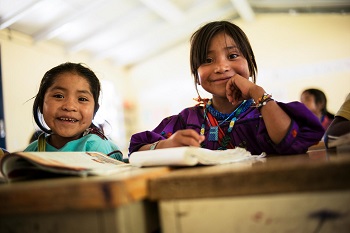Latin America and the Caribbean: a decade lost in ending child marriage
Without accelerated progress, nearly 20 million more girls in the region will be married in childhood by 2030
Latin America and the Caribbean (LAC) is the only region in the world where the prevalence of child marriage and early unions has not decreased in the last decade, UNICEF’s Regional Office for Latin America and the Caribbean said on Apr 10, 2018.

Girls in school in Wixarica, Nuevo Colonia, Mexico.
Levels of child marriage in Latin America and the Caribbean has remained at around 25 per cent for the past decade, while other areas of the world have seen significant declines, most notably South Asia where levels of child marriage have dropped from nearly 50 per cent to 30 per cent in the past decade.
In LAC child marriage and early unions among indigenous girls, girls living in rural areas, and medium and low-income population groups appear to be higher than those in urban areas and high- income quintiles. In the region non-matrimonial early unions are more frequent than formal, legal marriage.
"What we are seeing in other parts of the world is real progress to protect girls from child marriage, and this is cause for celebration. However, this is not the case in our region where one in four women was married or in union before the age of 18." said Maria Cristina Perceval, UNICEF Regional Director for Latin America and the Caribbean. “Girls that are forced to marry or enter in union before they turn 18 are deprived of immediate and long-term opportunities that ultimately affect the fulfilment of their rights. The increased risk of sexual violence, early motherhood, school abandonment – in addition to social exclusion from their peer group – is a clear indicator that the girls of LAC are being, and will continue to be, left behind if we do not take action now.”
Worldwide, an estimated 650 million women and girls alive today were married as children, with Latin America and the Caribbean home to around one in ten of those. Without accelerated actions and investment, Latin American and the Caribbean will have the second highest prevalence of child marriage in the world by 2030, behind only Sub-Saharan Africa, and ahead of South Asia, a region that has traditionally had the highest prevalence of child marriage in the world. If current trends continue, almost 20 million more girls in Latin America and the Caribbean will be married in childhood by 2030.
One of the main reasons that child marriage and early unions in LAC have not reduced is related to the equally high (second in the world) adolescent pregnancy rates and risk of sexual violence for girls (1.1 million adolescent girls report having experienced sexual abuse). These combined factors of gender inequality for girls in LAC stunt their options and opportunities.
Poverty also contributes to child marriage and early unions which, combined with gender norms, roles and relations, influence beliefs and decisions that early union is acceptable, even desirable, as a life choice. Additionally, gaps in national legislation can either permit marriage before the age of 18, or include exceptions to allow it with parental consent, legal representative or judicial authority.
“Girls’ equality is restricted in the region through combined impacts of early motherhood and unions, violence and limited life opportunities. We can no longer keep our eyes closed to their lost potential and forgotten rights. That is why, together with our sister agencies UNFPA and UN Women, we have launched a regional programme, calling urgently to end these practices in the region. We invite other partners to join this cause," concluded Perceval.
Source:United Nations Children's Fund
- 264 reads
Human Rights
Fostering a More Humane World: The 28th Eurasian Economic Summi

Conscience, Hope, and Action: Keys to Global Peace and Sustainability

Ringing FOWPAL’s Peace Bell for the World:Nobel Peace Prize Laureates’ Visions and Actions

Protecting the World’s Cultural Diversity for a Sustainable Future

Puppet Show I International Friendship Day 2020

